
We get an update from journalist Akram al-Satarri in Gaza, as Israel orders the full evacuation of all civilians from Gaza City after one of the deadliest days in Gaza in weeks. An Israeli airstrike killed at least 30 Palestinians at a school housing displaced people near Khan Younis, mostly women and children. “There’s no safe haven” anywhere in Gaza, says al-Satarri. “The people who are bearing the brunt of those bombardments are the Palestinian displaced people.” He also responds to ceasefire talks.
Transcript
AMY GOODMAN: As ceasefire talks are being held in Doha, Israel is intensifying its war on Gaza. Earlier today, the Israeli military ordered the full evacuation of all civilians from Gaza City. Al Jazeera reports Tuesday was the deadliest day in Gaza in weeks. At least 30 people were killed in an Israeli airstrike on a school housing displaced Palestinians near Khan Younis. Most of the dead were reportedly women and children. It was the fourth Israeli attack on a school over the past four days in Gaza. Al Jazeera aired footage showing children playing soccer at the school at the time of the blast.
The Palestinian Ministry of Health in Gaza decried the attack as a, quote, “heinous massacre against displaced citizens,” unquote. Eyewitnesses said the Israeli attack resulted in body parts flying through the air.
ASMAA QUDEIH: [translated] We were sitting safely in the afternoon, somewhat settled. Suddenly, a missile was fired. I’m not sure what kind of missile, F-16 or not, Apache. The schools were overcrowded with people, and the street was full, too. Suddenly, a missile hit and destroyed the whole place. There were bodies and body parts. Bodies flew. Body parts flew in the air. I don’t know how to describe it. I can’t. People sitting safely, selling goods, making a living to provide for their children. No one. I don’t know what happened. Why would they hit us like that?
AMY GOODMAN: We go now to Gaza, where we’re joined by journalist Akram al-Satarri. He’s joining us from outside the Al-Aqsa Hospital in Deir al-Balah in central Gaza.
I know that there’s a time delay, but, Akram, if you can describe exactly what has happened in what’s being described as the deadliest 24 hours in a number of weeks?
AKRAM AL-SATARRI: Yes, indeed, the deadliest 24 hours in a number of months, rather than weeks, heavy bombardment taking place in different parts of the Gaza Strip, including Gaza north, Gaza City, Gaza central area, Khan Younis area and also Rafah area. In Khan Younis only, 27 people out of 56 people who were killed in the last 24 hours were killed in that area. One shelter that was used by hundreds of families and one tent — one area that was used by families as a shelter outside of the school were targeted by three missiles that brought to that heavy loss amongst them. Twenty-seven children, women, elderly people and youth, as well, were killed. More than 52 other people were killed. Al-Nuseirat area also, 24 hours also ago, witnessed a large-scale incident, where around 19 Palestinians were killed and around 70 others were injured. Rafah also has been witnessing large-scale bombardment that has been taking the lives of tens of Palestinians. Gaza central area also, besides al-Nuseirat, al-Bureij also witnessed a targeting incident where around nine people were killed in a heavy crowded area in the middle of al-Bureij refugee camp, where thousands of displaced people were there and were trying to secure their very basic needs amidst that very critical situation characterizing a great deal of lack to the essential supplies for the people who are in need.
So, the bombardments are technically everywhere in the Gaza Strip. The people who are bearing the brunt of those bombardments are the Palestinian displaced people and the Palestinians from Khan Younis, Rafah, Gaza central area, Gaza City and the north, who have been asked also to move from their areas. In Khan Younis area, around a quarter-million Palestinians were asked to head from the eastern part of the city to the western side of the city. In Gaza, around 300,000 Palestinians are already asked by the Israeli forces to leave the Gaza City and head south toward Deir al-Balah area and Khan Younis and Rafah. So, overall, tense situation that has been exacerbated by the Israeli measures, followed by the adverse development taking place not only because of the bombardment, but rather because of the very large-scale displacement, that reminds the Palestinians of the very first days of the war and even worse than that.
AMY GOODMAN: Can you tell us, Akram, about the reports that flyers are being dropped all over Gaza City telling everyone to leave, what exactly this means? We are seeing that the Palestinian Red Crescent has said its teams are receiving dozens of humanitarian distress calls from residents in Gaza City, where the ambulances and medics are not able to enter because, the Red Crescent described, the intensity of the bombardment of the area. What is happening in Gaza City?
AKRAM AL-SATARRI: Yes, the intensity of the bombardment in that area, Gaza area, is coupled with the requests that were made by the Israeli forces asking around 400,000 Palestinians who are living in Gaza, including also the internally displaced people, to head south. And they were describing the route to head south, and they were saying that Salah al-Din Street and also another, al-Rashid Street area, are the safe routes for the Palestinians to make it to the announced humanitarian shelters and routes as described by the Israeli occupation forces, while, unfortunately, there’s no safe haven in Gaza, no one safe, no place safe, according to the description that was made by the commissioner general of the U.N. That means a new round of massive displacement is planned by the Israeli occupation forces, not only in Gaza City, where 400,000 Palestinians are staying, but also in Khan Younis area, where is a quarter-million of Palestinians that were asked to move to the eastern — or, western part of the city.
So, those actions are now leading to more despair, leading to more displacement, and are likely also to lead to more destructions once the Israeli occupation forces start the destruction in that area, which they have started at a very large scale in al-Shuja’iyya, in al-Sabra, in al-Daraj, in al-Tuffah and also in al-Saraya area, which are main neighborhoods in Gaza, including the Gaza Old City, that is an historical place that has already been targeted by the Israeli occupation forces, as well, and a significant portion of it was destroyed.
AMY GOODMAN: I’m looking at a piece in The Guardian describing footage broadcast by Al Jazeera showing children playing football in the school’s yard when a sudden boom shook the area, prompting shouts of “A strike! A strike!” If you can explain what happened when the kids were playing soccer?
AKRAM AL-SATARRI: Well, apparently, obviously, there were targeted by the Israeli occupation forces. This is one of the incidents that was documented by the cameras. Unfortunately, hundreds more incidents are taking place without a camera being there to capture the horror that has been caused, the destruction that has been brought to the life and to the facilities, and the death that has taken the life. Families were divided. According to one of my friends who was there, who is an emergency doctor, they received 27 bodies of one family, and the only surviving member of the family was a 26-years-old — a 26-days-old child. So, many incidents are taking place. Many lives are wasted.
And when you look at the condition and the context and the way people were living when they were targeted, you come to a conclusion that people were just not doing anything. They were not engaging in combat activities. They were not carrying arms. They’re not fighting. They’re just plain people who are seeking some comfort, some rest and respite to their life amidst that ever-escalating military situation, amidst that ever-exacerbating humanitarian crisis. They were trying to play together — I mean the children. They were trying to find some time of peace, when their life was targeted and they were ending up dead.
And I think also most of them not only dead, but some of them are losing their limbs and end up like physically disabled, some of them losing their sight, which some of the people who are reporting about some of the children who were injured were losing their eyes and losing their ability to sense things. One of them lost their four limbs, a child, a baby boy, who lost his four limbs. So, you can’t imagine, and I don’t think you can ever be able to imagine the level of distress that has been caused.
People who have been communicating with the Palestinian Red Crescent Society are people who were trapped under the rubble of their homes. The story of al-Helou family, that was targeted in Gaza City, and around 19 family people were killed, and the only survivor, who was 19 years old, was communicating with the Palestinian Red Crescent and was telling them that he cannot help his family and that his mother was killed and that she is on his lap and that his father is screaming from under the rubble and seeking help. And his brothers and sisters were also seeking help by screaming, and no one could help them, because the Palestinian Red Crescent Society cannot go to those areas where some fighting is taking place; otherwise, they would be targeted. And we have seen different incidents where the Palestinian Red Crescent Society teams were targeted, and even international organizations, like the World Central Kitchen and also some other organizations, the UNRWA, were targeted, and they ended up losing some of their staff.
AMY GOODMAN: Yes, UNRWA, their headquarters were hit. UNRWA Commissioner-General Philippe Lazzarini wrote today, “4 schools hit in the last 4 days. Since the war began, two thirds of @UNRWA schools in Gaza have been hit, some were bombed out, many severely damaged. Schools have gone from safe places of #education & hope for children to overcrowded shelters and often ending up a place of death & misery. Nine months in, under our watch, the relentless, endless killings, destruction and despair continue. Gaza is no place for children. The blatant disregard of international humanitarian law cannot become the new normal … Ceasefire now before we lose what is left of our common humanity.” Again, those are the words of the UNRWA commissioner-general, Philippe Lazzarini, the Palestinian relief and works agency. Your comment on the ground, Akram, and if you can also respond to whether people on the ground are hearing about the negotiations that are taking place — well, it was in Cairo, now in Doha — around a ceasefire?
AKRAM AL-SATARRI: Landslide majority of the Palestinians are disconnected from the external world. They don’t have internet. They don’t have electrical supplies. They don’t have access to any communication whatsoever. So, unfortunately, most of them, in the past who were extremely interested, they were trying to go to the places where they have electrical supplies due to having the PV panels or where they have been following the news, but now people are extremely busy surviving.
They have been linking any talk about the negotiation and any analysis about any breakthrough when it comes to negotiation and a swap deal with the major developments taking place on the ground. Like, whenever they talk about negotiation, they understand that the Israeli government is going to start a large-scale military step where they would be targeting Gaza. And the very same thing practically is happening. They were talking about the negotiation in Doha and Cairo in the media, and then, the day after, the Israeli occupation forces started that large-scale ground operation in Gaza, and now they’re asking 400,000 Gazans to leave Gaza City and move to the south of Gaza. And they’re asking quarter a million to move from the first half of Khan Younis to the other half of Khan Younis.
So, people are pessimistic about the intention of the Israeli government to do anything whatsoever that can eventually lead to a ceasefire or to rest or respite or peace or comfort or safety or whatever thing that have to do with the rest of a humanitarian soul that has been haunted by the ongoing bombardment and loss and fear of imminent death. So, Palestinians are struggling. Unfortunately, most of them don’t have access to the internet, so they cannot continue following the news about the developments. But they have been seeing the developments with their own eyes.
I believe the ones who were killed in Khan Younis, the 27 family members and also the 52 others who were injured in a shelter that was supposed to be protected according to the international law, an UNRWA facility, they fully understand now that it is just a talk ’til something tangible happens, ’til some safety — sense of safety happens to them, until they can retrieve some normalcy to their life.
They made — the statements that are made by commissioner-general of the UNRWA are appreciated by the Palestinians. They have been seeing the UNRWA struggling for the sake of providing them with the life-saving medication, food, water and nonfood items. However, they understand that the Israeli occupation is not listening to any call, except the call of war and fighting. And they understand on the ground that they have been the prime target of that unleashed power and fire that is targeting them. As you can hear in the background, more injured people, presumably, are coming to the hospital, and the bombardment is still ongoing. People are still killed. And they understand that nothing serious has been done to stop that, neither by the international community, nor by the different U.N. agencies that are mandated to condemn the atrocities and to stop them, as well, and hold accountable the perpetrator of those.
AMY GOODMAN: I want to thank you so much for being with us, Akram al-Satarri, journalist based right now, speaking to us outside the Al-Aqsa Hospital in Deir al-Balah in central Gaza. Please be safe yourself.
The latest news out of Gaza when it comes to journalists, well, the Gaza government media office says over 150 Palestinian journalists have been killed — most recently, Palestinian journalists Saadi Madoukh and Ahmad Sukar killed Friday, following an Israeli raid that targeted a home of the Madoukh family in the Daraj neighborhood of Gaza City. The New York-based Committee to Protect Journalists says well over 100 media workers have died since October 7th. They are saying, the Committee to Protect Journalists, that the killing of journalists in Gaza makes it the deadliest period since CPJ, the Committee to Protect Journalists, began gathering data in 1992.
This is Democracy Now! Coming up, Dr. Mustafa Barghouti, Palestinian physician, activist, politician. He’s usually in Ramallah but is in Washington, D.C., right now. Stay with us.

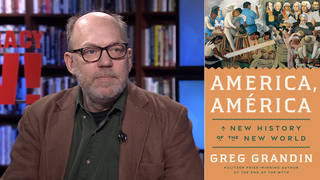
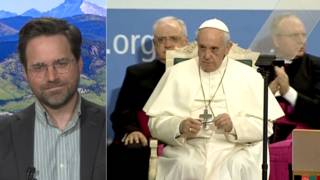
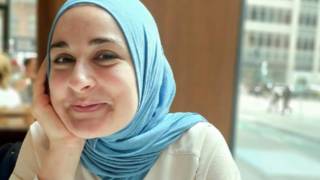
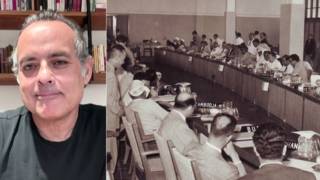
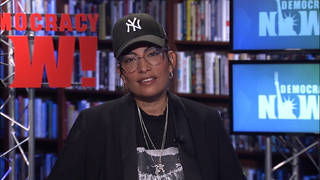
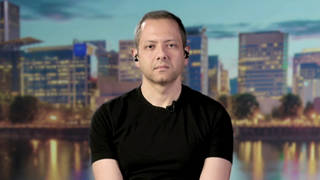

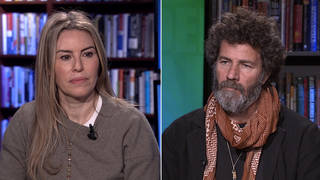

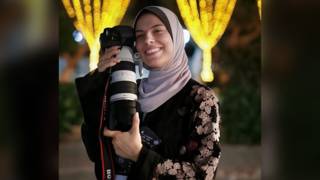

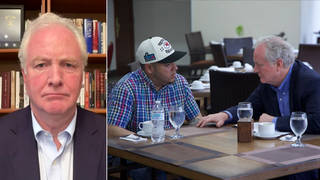
Media Options